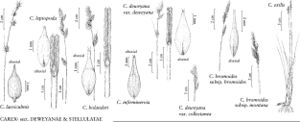familyCyperaceae
genusCarex
sectionCarex sect. Deweyanae
speciesCarex bromoides
subspeciesCarex bromoides subsp. bromoides
Carex bromoides subsp. bromoides
Plants densely to loosely cespitose. Rhizomes short to long, internodes 0.2–20 mm. Culms 0.5–1(–1.1) mm wide. Widest leaf blades 1.3–2.9(–3.1) mm wide. Longest inflorescences (33–)40–63(–71) mm. Perigynium beak 0.3–0.42 times as long as perigynium. 2n = 64, 66, 68.
Phenology: Fruiting spring–early summer.
Habitat: Forested flood plains, wet hardwood forests, hardwood swamps, occasionally wet meadows, marsh edges
Elevation: 0–500(–1100) m
Distribution

N.B., N.S., Ont., Que., Ala., Ark., Conn., D.C., Del., Fla., Ga., Ill., Ind., Ky., La., Maine, Md., Mass., Mich., Minn., Miss., Mo., N.H., N.J., N.Y., N.C., Ohio, Pa., R.I., S.C., Tenn., Tex., Vt., Va., W.Va., Wis., c Mexico.
Discussion
Selected References
None.
Lower Taxa
None.
... more about "Carex bromoides subsp. bromoides"
N.B. +, N.S. +, Ont. +, Que. +, Ala. +, Ark. +, Conn. +, D.C. +, Del. +, Fla. +, Ga. +, Ill. +, Ind. +, Ky. +, La. +, Maine +, Md. +, Mass. +, Mich. +, Minn. +, Miss. +, Mo. +, N.H. +, N.J. +, N.Y. +, N.C. +, Ohio +, Pa. +, R.I. +, S.C. +, Tenn. +, Tex. +, Vt. +, Va. +, W.Va. +, Wis. + and c Mexico. +
Forested flood plains, wet hardwood forests, hardwood swamps, occasionally wet meadows, marsh edges +
Present +
Sp. Pl. +
1805 +
Illustrated +
Carex bromoides subsp. bromoides +
Carex bromoides +
subspecies +
